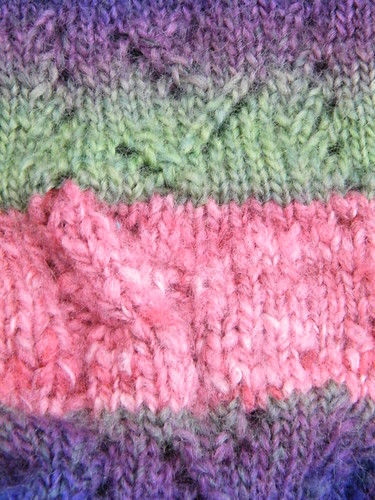K = knit
P = purl
These are the two basic stitches. Tell us how many stitches you’d like us to knit or purl like this: k15 or p4.
You can also make a set of instructions as follows: k2, p6, k2, p6, k to end of row.
You can specify the number of rows that we need to knit like this for as well, by adding (for three rows) or suchlike.
If you’d like something repeated, do it following a formula something like this: (k2, p3) 5 times
You can do more than just get us to make patterns with the knit and purl stitches. You can ask us to increase or decrease the amount of stitches in a number of ways, make eyelet holes, ask us to change colours, turn the knitting round and go the other direction or make a buttonhole.
Increase stitches
m1 = make one by picking up and knitting a stitch between two other stitches
kfb = knit front and back
yo = yarn over
yf = yarn forward
Decrease stitches
k2tog = knit two stitches together
p2tog = purl two stitches together
ssk = slip two stitches knitwise, transfer them back and knit them together
Other things to do
Eyelets: yo k2tog = makes an eyelet
Buttonholes: specify the number of stitches width eg: bh5
Change direction: as it says, turn the knitting and work back the other way (as in short row shaping)
Change colours: to make stripes or coloured patterns
Change needle sizes (to larger or smaller ones)
There are many more things you can do in knitting than just these, but these basics should help both the instructors and makers in the performance.
Here are some great examples of ways that you could incorporate knitting instructions into your tweets (with thanks to my fellow Steering Committee member Jonny Gray!)
Tweet01: sl1, k1 *m1, p2, k2tog, p1* (repeat from * three times) k to end #plateaknit
Tweet02: Do two rows in the color you are currently working with then change to something (more) green. #plateaknit
Tweet03: Change one of your needles up three sizes #plateaknit
Tweet04: Add five stitches to your next row in any way of your choosing #plateaknit
Tweet05: Bind (cast) off and start a new piece. #plateaknit
Tweet06: Do the next five rows in a k2, p2 rib. #plateaknit
Tweet07: Over as many rows as you choose, reduce the row to ten stitches wide then expand back to the original number of stitches in the row. #plateaknit
Tweet08: Do a short row of half the number of stitches in your current row. #plateaknit
Tweet09: Weave in a length of packaging twine into part of a row. Leave at least 6 inches of twine dangling on the RS of the piece at both ends of the weave. #plateaknit
Tweet10: Repeat the last instruction five times. #plateaknit
Tweet11: Make it shine! #plateaknit
Of course the makers could also, in the spirit of Lee Meredith’s Game Knitting choose not to use any of the ‘instruction’ tweets as direct instructions and instead do something (for example knit an eyelet or change colours) whenever a particular word such as ‘and’ or ‘row’ is mentioned in a tweet or when somebody talks about food. It really is up to you how off the wall you want to make it! Basically, makers will interpret instructions to the best of their abilites, including (if they choose) interpreting any part of an instruction tweet as additional guides.
Whatever you do with it, however simple or complicated you want to make it, just have fun!












No comments:
Post a Comment